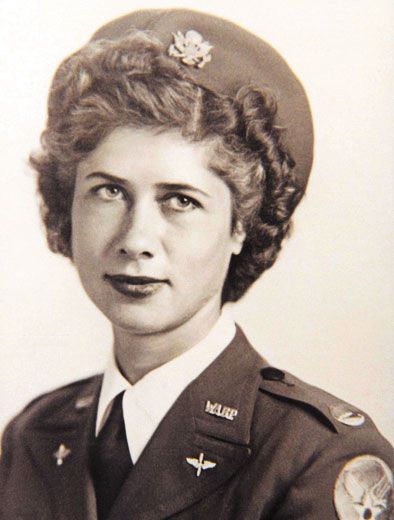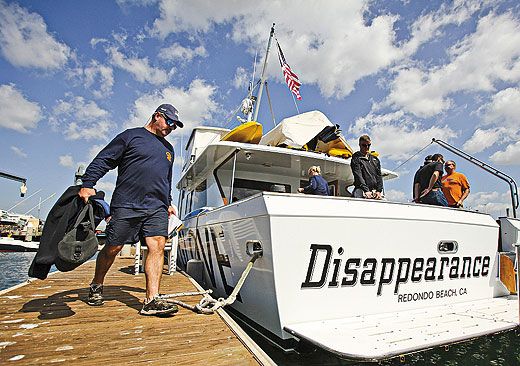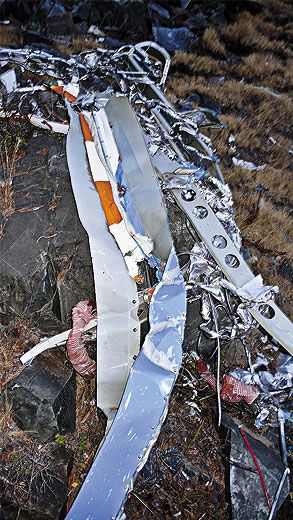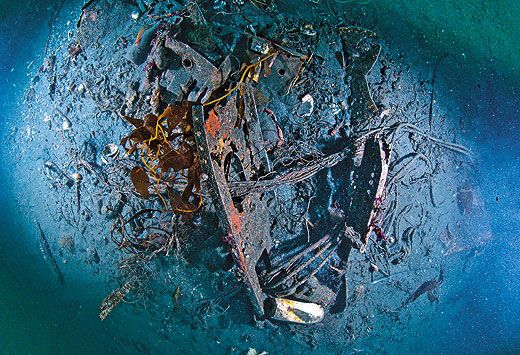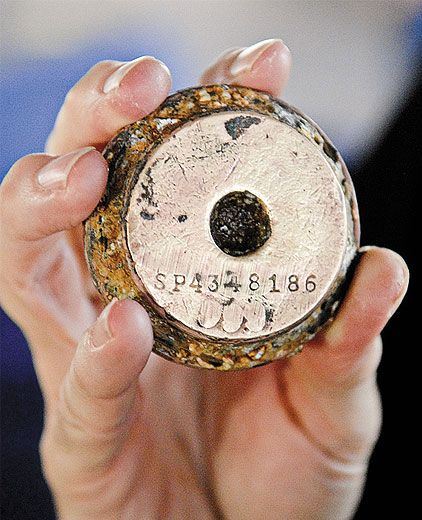Cold Case
A new team sets out to solve old disappearances.
/https://tf-cmsv2-smithsonianmag-media.s3.amazonaws.com/filer/COLD_CASE_FLASH.jpg)
On Thursday, October 26, 1944, 12-year-old Frank Jacobs did what he always did when school got out: He walked a half-mile to the Manhattan Beach pier, where he liked to fish for halibut. Jacobs settled in a spot on the pier’s north side, which gave him a view of aircraft departing from Mines Field (now Los Angeles International Airport), about three and a half miles south. He loved catching a glimpse of an American fighter.
Airplanes departing Mines usually head west, over the bay. And that autumn afternoon was no different: Jacobs noticed the roar of a single-engine airplane climbing over the water. Though the boy built balsawood models of aircraft used in World War II, he could not identify this airplane. But he suspected it was a P-51 Mustang.
Suddenly something odd happened.
“There was this sputtering sound and then total silence,” recalls Jacobs. He watched stunned as the aircraft pitched upward, then pitched nose down and began falling. Jacobs alerted three bystanders, but none seemed concerned. Seconds later, the aircraft disappeared silently into the fog.
Jacobs climbed onto the pier railings and strained to get a better look. “I don’t even know if it went in the water because the cloud deck was so low,” he says. “But I assume it couldn’t have pulled up because there was no more engine noise.”
Jacobs spoke to a nearby shopkeeper, who said if there had been an accident, the authorities knew about it. The boy went home and told his father; “He didn’t believe me either.”
Several days passed; the newspapers reported nothing. Months went by, then years.
In 2005, Jacobs was reading the Daily Breeze, a South Bay paper in Los Angeles, and saw a story that finally identified what he had seen that day. It was indeed a P-51D Mustang, factory-fresh, and the pilot was a woman, Gertrude Tompkins.
Tompkins, 32, had been flying for the Women Airforce Service Pilots, a World War II program that enlisted 1,074 women to ferry military aircraft, primarily between U.S. military bases. She had been part of a flight of three Mustangs headed to Newark, New Jersey, on a hopscotch route that would take four days. But her canopy had a locking problem, so her two fellow pilots took off without her, flying over water and then banking left, toward Palm Springs. Tompkins took off a few hours later, following the same flight path.
When the first two pilots arrived in Palm Springs and didn’t see Tompkins, they assumed the canopy malfunction had grounded her. But after landing in Newark, they learned that nobody had seen or heard from Tompkins.
For three weeks, crews searched Santa Monica Bay and the surrounding area for Tompkins’ Mustang. They turned up nothing, and eventually called off the search. Tompkins was the only WASP who disappeared and was never found.
Jacobs called the reporter who had written the Daily Breeze piece, Ian Gregor, who put him in contact with Pat Macha of Aircraftwrecks.com, a historian of aviation accidents. Macha had been collecting evidence on the Tompkins case for years and had organized searches for her airplane.
Macha and Jacobs went to the pier, and Jacobs pointed out where he had seen the aircraft fall. “The memory has always haunted me,” says Jacobs, now 78 and a retired aerospace engineer for Northrop Grumman. “I have always felt that somebody died that day.”
Now another search for Tompkins is on. This one is being led by a group of volunteers called the Missing Aircraft Search Team. With a diverse set of specialized skills, MAST’s members hope to locate long-lost aircraft and, in some cases, the remains of the pilots and passengers.
In the United States, there are more than 180 cold cases involving civilian aircraft that have gone missing, plus an uncalculated number of military airplanes that have disappeared. MAST considers taking a case when asked by family members of the missing, or by the agency with jurisdiction over the disappearance.
IT IS EARLY OCTOBER 2009, and I am staring at a TV monitor relaying live images from a video camera being dragged along the bottom of Santa Monica Bay in search of Tompkins’ P-51. Next to me on the bridge of his yacht, Disappearance, is Bobby Meistrell, the 81-year-old co-founder of Body Glove, the company that developed the modern-day wetsuit. Meistrell has volunteered his boat and submersible camera for the search.
Hoping his camera will capture a glint of metal protruding from the sandy bottom, Meistrell steers the Disappearance in tight circles. We’re two miles west of LAX; departing jetliners pass overhead nonstop. It’s a pleasant fall morning, and calm seas make for ideal search conditions.
MAST’s origins go back to early 2008. One of its members, Robert Hyman, a photographer, explorer, and mountaineer who has led expeditions, had been following the news reports on the search for Steve Fossett, a wealthy aviation record-breaker who had disappeared in September 2007 (see “Anatomy of a Search,” Feb./Mar. 2008). Like Fossett, Hyman is a fellow of The Explorers Club. “When they couldn’t find Steve, I said to myself, ‘I could put a climbing team together to help the official searchers reach some of the extreme vertical terrain where he might have crashed,’ ” Hyman says.
He tapped Lew Toulmin, a disaster response manager who has consulted for the World Bank and U.S. Agency for International Development, and Colleen Keller, a senior analyst at the scientific consulting firm Metron. Working for the U.S. Coast Guard, Metron had created SAROPS (Search and Rescue Optimal Planning System), which can examine winds, tides, and currents, then recommend where searchers should focus their efforts. While SAROPS is designed for ocean operations—its models located wing debris and bodies from Air France Flight 447, which crashed off the coast of Brazil in June 2009—Keller used the methodology, along with Google Earth satellite photographs, to reconstruct several possible scenarios for Fossett’s last flight. She then ranked the routes in order of probability.
Next, Hyman recruited 28 searchers, and in September 2008 the team spent two weeks scouring the mountains near the Flying M Ranch in Nevada, Fossett’s last known point of departure. The group failed to find Fossett’s Bellanca Super Decathlon, but one of the tracks they identified with radar data from his flight passed over the spot where the famed aviator’s remains were later discovered.
“We all bonded during the experience,” says Hyman. For him, the search planted a seed: A team of search-and-rescue sleuths armed with the latest technology and schooled in advanced search methods could potentially solve some of history’s aviation mysteries.
The new group decided to make its first case a Cessna 182 carrying Marcy Randolph, 43, and pilot William Westover, 54, that had vanished in 2006 on a sightseeing flight from Phoenix to Sedona, Arizona. The members gathered data—radar tracks, cell phone records, satellite images—and made plans to conduct both air and ground searches. Keller assembled a report with 14 scenarios describing how and where the Cessna might have crashed. Rather than investigate all of them, she asked MAST members to rank each scenario’s likeliness on a 1-to-10 scale. On April 13, 2009, Chris Killian, a telecommunications executive and wreck hunter who has discovered more than 100 military aircraft, called the U.S. Forest Service to find out whether the group needed hiking permits to access the most likely sites. “While he was on the phone, it occurred to him to ask for fire reports,” says MAST co-founder Tim Evinger. Killian learned that the day the Cessna had gone missing, hikers passing by one of Keller’s scenario sites had reported a fire; they had even taken a photograph of it. “Lo and behold,” says Evinger, “[the airplane] was there.”
In April 2009, while examining high-resolution sonar data in preparation for the Tompkins search, MAST, working with two other search groups, UB88.ORG and Aircraftwrecks.com, located debris on the ocean floor later identified as parts of a Lockheed T-33A Shooting Star trainer that had disappeared in 1955 with two Air Force lieutenants in it. (The parts have since been retrieved by the local sheriff’s department.)
MAST members have paid for expenses themselves. The Tompkins search easily exceeded $30,000, and had volunteers charged for their services, the cost would have been well over $1 million. The group is in the process of becoming a non-profit, able to accept donations for searches.
The group has 12 members. If a search is under way, MAST will use mission-specific experts. For the Tompkins search, the crew includes sonar technicians, commercial divers, sport fishermen who know Santa Monica Bay well, a cave cartographer, an off-duty FBI agent, and a guy who inspects the water outfalls at nuclear power plants (he’s particularly adept at squeezing into tight spaces, underwater, in the dark). In all, more than two dozen volunteers, including members of UB88.ORG and Aircraftwrecks.com, have come from around the country to participate, including three members of Tompkins’ extended family.
From talking to them, and to Pat Macha, who helped coordinate the dive volunteers, I learn a little more about the pilot: Born in 1912 and raised in a quiet New Jersey suburb, she was the third of three girls. After getting an undergraduate degree from the Pennsylvania School of Horticulture, she met a pilot, a Brit living in the States. They fell in love and became engaged, and he taught her to fly. Tompkins stuttered, says grand-niece Laura Whittall-Scherfee, but the stuttering stopped after she learned to fly. When the war began, her fiancé joined the Royal Air Force, and was later shot down over England and killed. By then Tompkins had caught the flying bug, so in 1943 she joined the WASP. She married a movie producer named Henry M. Silver (though did not take his name) a month before she disappeared.
To identify the most promising dive sites, Gary Fabian of UB88.ORG had acquired a scan of Santa Monica Bay the U.S. Geological Survey (USGS) had produced in October 1996 with a multi-beam echo-sounder, a device that showers the ocean floor with sound pulses. The returns from the pulses render a three-dimensional snapshot, similar to a topographic map. From the scan, Fabian winnowed more than 55 elevations that might be remnants of Tompkins’ P-51.
While the multi-beam had good enough resolution to establish targets, it could not tell the searchers what the targets were. “We used the side-scan to create a better image,” explains Gene Ralston. Ralston and his wife, Sandy, are renowned for their mastery of the side-scan sonar, which generates high-resolution images of objects on the seabed. The sonar, which resembles a Sidewinder missile, mounts to the bow of the Ralstons’ 23-foot aluminum skiff. Gene uses a winch to lower the device into the water until it is hovering about 10 feet above the bottom. It is coupled to a 1,000-foot cable that relays the sonar data back to the operator. The boat motors slowly, towing the sonar.
In saltwater, “things that might survive include the machine guns, the engine—especially the crankshaft because it is very hard metal—seat armor, and wheels,” Toulmin says. Because of the scan’s high resolution, says Ralston, “we can detect things as small as a beer can, and under the right conditions”—like the ones in the bay, where the water is very clean and the packed-sand bottom is smooth for miles—“things stand out really easily.”
The Ralstons also own a remotely operated vehicle, about the size of a small beach cooler, that carries a video camera. If the sonar picks up something promising, Gene can deploy the tethered ROV to get a quick peek at it. But the ROV has limitations—it is slow, and ocean currents make it hard to steady—so during the Tompkins search, the targets are investigated by scuba divers, who make numerous descents into the 45-degree-Fahrenheit water. By the end of the first day, divers had found a 1950s wooden powerboat, an anchor, and a pair of washing machines full of lobsters. So far, no Mustang.
Because MAST cannot take every cold case, it focuses on the most promising candidates. For the oldest cases, eyewitness reports are essential. But for more recent incidents—those in the past 10 or 15 years—technology plays a larger role. Before taking a case, MAST members want to know whether anyone in the missing airplane carried a cell phone, and whether its data are still available. Because cell phones must always be ready to place a call, they maintain reception by regularly emitting pings to nearby towers, a process that is tracked and recorded by service providers. MAST’s Tim Evinger, the sheriff of Klamath County, Oregon, and the head of the privately funded Fossett search, used his skills in cell phone forensics to help solve the Cessna case. One of the two people aboard the aircraft had been carrying a cell phone; Evinger correlated data from the service provider with one of many unidentified aircraft radar tracks in the region. The association helped MAST narrow the search area.
Radar tracks made minutes before a crash can provide vital clues to the aircraft’s general vicinity. The problem, says Evinger, is that radar data isn’t always archived.
Emergency locator transmitters—and newer devices called personal locater beacons and SPOT Personal Trackers—can tell a satellite your location within a few yards. Data emitted from any of these gadgets can lead searchers to a missing aircraft. But pilots are not required to carry them.
Evinger muses about a day when airplanes and passengers are so wired that getting lost simply won’t be possible. In the future, he says, our activities will always leave an electronic trail.
DAY TWO OF THE SEARCH. Two finds are intriguing: The first is a general aviation aircraft from which divers recover an instrument panel. (It was later identified as part of a Cessna 210C. Both occupants survived the June 1973 crash in the bay, and MAST interviewed them.) The second are drainage plugs from an airplane fuel tank. They have part numbers, and MAST is continuing to research them.
In seven days, 12 divers, reaching depths up to 270 feet, clear 44 targets. They find boulders, orange highway cones, lobster traps, a sailboat, a mysterious metal box, and a 30-foot-tall telecommunications antenna. Gene Ralston conducts a second pass with the side-scan sonar, ruling out the remaining targets.
MAST did not locate the Mustang. Is it possible the searchers missed it? MAST’s Hyman has doubts: “Divers always say that items on the ocean floor tend to displace current and sediment deposits, leaving them exposed, if large enough—like the T-33 plane we located.”
But Rikk Kvitek, director of the Seafloor Mapping Laboratory at California State University at Monterey, e-mails me that in Santa Monica Bay, there has been “significant deposition of fine sediments in the 1900s. This could easily cover and/or obscure the low-relief wreckage of a small aircraft.” Pete Dartnell of the USGS in Menlo Park, California, has measured the depths of Santa Monica Bay, and agrees: “This is a dynamic environment with the potential to bury small wreckage.”
MAST’s Colleen Keller thinks it is “highly likely that the wreckage is buried. For a while we were discussing trying to involve U.S. minesweeping assets to search the near-shore area for wreckage just beneath the surface. Deeper water would present more significant problems. These are highly localized sensors…the veritable needle-in-the-haystack situation.”
It’s possible, too, that the Mustang is in a less likely part of the bay, outside the 60-square-mile zone that MAST, deeming it the most promising, chose for the search.
Or it may not be in the bay at all. That’s the theory of 87-year-old Duncan Miller, who dated Tompkins while he was attending fighter pilot school. Miller, who remembers Tompkins as “a very nice, high-class girl” and “very stable,” says, “It is my feeling that she crashed in the mountains east of Los Angeles.” His reasoning: Pilots hate flying over water because an emergency landing is much more difficult, as is survival afterward. Miller’s scenario would explain why young Frank Jacobs never heard a splash when he watched that silver airplane fall from the sky. Even so, at the end of the dive, Laura Whittall-Scherfee was grateful to MAST for eliminating so many targets, saying: “Although Gertrude’s Mustang continues to elude us, you brought us ever closer to our target.”
MAST does not promise to solve every case it takes on. Limited in time, technology, money, and number of volunteers, it does what it can, and if further work looks unpromising, it will move on. The group is now investigating the case of retired commercial airline pilot Court Mumford, who left Aurora State Airport in Oregon on July 7, 2007, in a Sport Cub and never returned. Killian wants to look for Carroll and Ruby Webb and their son William, who disappeared in 1967 in a Piper Cherokee flying from San Jose, California, to Ogden, Utah. Meanwhile, the Ralstons are making preparations to use their side-scan sonar in Flathead Lake, Montana, where, in 1960, Captain John Eaheart, a pilot with the U.S. Marine Corps Reserve, crashed his Grumman F9F Cougar.
MAST members are always eager to try the latest wizardry. Lew Toulmin tells me about NASA World Wind, software that, among myriad other functions, can put a searcher in the cockpit of a lost aircraft, generating a 3D image of what the pilot saw along his or her known (or presumed) route before the airplane went down. MAST tested the software for NASA during its Fossett search. “We would take a canyon and we’d be able to see a notch Steve might have gone through that isn’t perceptible just looking at a map,” Toulmin says.
Gene Ralston looks forward to the next generation of side-scan sonars, which boast far better resolution. He is also stoked about autonomous underwater vehicles, or AUVs, essentially submersible robots that can operate untethered at virtually any depth with no input from controllers at the surface. They have an onboard computer guidance system and collision avoidance sensors, and can be equipped with side-scan sonar, high-definition video, still cameras, and image processing software. A team of wreck hunters from the Waitt Institute for Discovery recently used two AUVs to look for Amelia Earhart’s Lockheed 10E Electra. They programmed thedevices to search 7,000 linear miles of ocean floor near American Samoa at an average depth of 17,000 feet.
Ralston speculates that future drones could be used to search for aircraft on the ground. Instead of being directed by a controller and a joystick, the craft would essentially think for themselves. “They could fly over an area looking for specific colors, like a piece of clothing, and then analyze the image,” Ralston says.
For now, Hyman has more modest dreams. “The [Tompkins] search still has legs,” he says, “and we want to go back [to the bay] with a small footprint”—perhaps one boat, a side-scan, and a couple of divers. The UB88.ORG and Aircraftwrecks.com teams continue the search as well, and now the Navy is assisting. But even if P-51 parts are found in the bay, after 60-plus years, any evidence they once bore showing why the aircraft went down may be long gone, leaving part of the Gertrude Tompkins mystery still unsolved.
Michael Behar regularly contributes to several publications, including Outside, Men’s Journal, and Wired.
